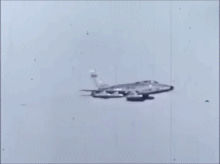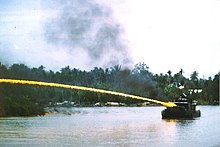Napalm
Napalm or gelatinous gasoline is a fuel that burns longer than simple gasoline. This feature has made it used by some armies in various wars. The name napalm comes from the acronym for naphthenic acid and palmitic acid, with which it is manufactured. In 1972, during the Vietnam War, a Vietnamese reporter captured a photograph of children fleeing napalm dropped by US forces. In the center of the image is a girl named Phan Thi Kim Phuc. The photo, published by several newspapers three days later, had an impact due to its representation of the war. According to The New York Times, the photo "fueled growing anti-war sentiment in the United States and perhaps hastened the end of the war."
History
During World War II, the Allies and Nazi Germany used gasoline as a weapon in flamethrowers, as gasoline alone was a fast and effective incendiary device. An additional substance was necessary to produce a powerful and persistent combustion but not to be consumed quickly.
Although researchers had found ways to make gasoline turned into gelatin, many of them required rubber as the main component, which during wartime was a scarce commodity. In 1942, researchers at Harvard University (led by Louis Fieser) and the US Army Chemical Corps found the solution: napalm.
Incendiary bombs using napalm as their fuel were used in the bombing raid against the German city of Dresden and against Japan.
After the war, further refinement and development of napalm was undertaken by the United States Government and its affiliated laboratories.
Several countries have used napalm during armed conflicts. The Greek armed forces used it during the Greek Civil War, UN peacekeepers used it in the Korean War, Morocco in the Rif and Western Sahara, among others. However, it is the United States Army that has used this element the most during its numerous military incursions such as the Vietnam War or the Iraq War or supplying it to the Dominican Army of Rafael Leónidas Trujillo, in the expedition of 14 June or the army of Fulgencio Batista during the Cuban Revolution.
Napalm has recently been used in Villarica, Colombia (1953-54), Western Sahara (1976-77), Iran (1980-88), Israel (1967, 1982), Brazil (1972), Nigeria (1969), Egypt (1973), Cyprus (1974), Argentina (1982), Iraq (1980-88, 1991), Serbia (1994), Turkey (1974, 1997), El Salvador (1980-1992) and Angola. In addition, it was the main weapon used by the Ethiopian dictator Mengitsu to put down the Eritrean insurrections.
The Napalm Girl
On June 8, 1972, during the Vietnam War, an American plane dropped a napalm bomb on the area of the town of Trang Bang. Sheltered in a pagoda was nine-year-old Kim with her family. They had to flee from there, so they ran to the road, where she saw how a plane was heading towards her and suddenly the fire burned all her clothing. She ran outside as her skin flaked from the napalm, which had burned two-thirds of her body.
While jogging down the road, Vietnamese photographer Nick Ut captured the iconic image without her realizing it. He then took her to the hospital in the area, but they did not want to receive her because they did not know how to treat her. Nick identified himself as an Associated Press photographer and threatened to tell the newspapers the next day that the girl had not received care. The doctors then covered her wounds and the next day she was transferred to Saigon Children's Hospital, while her family did not know her whereabouts as they had lost her on the road. But at her Children's Hospital they did not know how to treat her either and they transferred her to the morgue to wait for her death. Decades later, a doctor specializing in napalm explained to her that the bandages and the lack of treatment saved her life because napalm reacts to contact with oxygen and combusts again, instead, she spent three days lying in the morgue, with the chemical turning off Finally, her brother found her and they took her to another hospital, where she was hospitalized for more than a year, during which she would undergo numerous skin graft operations and later years of therapy.
Kim has described her experience: "napalm is the most excruciating pain imaginable...water boils at 100 degrees Celsius, napalm generates temperatures of 800 to 1200 degrees Celsius." The influence of the photo taken by Nick was such that some historians have considered that the image helped stop the war in Vietnam.
Development
The use of fire in warfare has a long history. Greek fire, also described as "sticky fire" (πῦρ κολλητικόν, pýr kolletikón), is believed to have been petroleum-based. The development of napalm was precipitated by the use of gelled gasoline mixtures by the Allied Forces during World War II. The use of aluminum salts of organic acids (Ionov's Salt) for the preparation of viscous incendiary mixtures was already made by the Soviets in 1939, to great acceptance by the Red Army. Latex, used in these early forms of incendiary devices, became scarce, as natural rubber was almost impossible to obtain after the Japanese Army captured rubber plantations in Malaysia, Indonesia, Vietnam and Thailand.
This shortage of natural rubber led chemists at US companies such as DuPont and Standard Oil, and researchers at Harvard University, to develop a factory-synthesized alternative: artificial rubber for all uses, including tires vehicle tracks, tank tracks, gaskets, hoses, medical supplies, and rain gear. A team of chemists led by Louis Fieser at Harvard University were the first to develop synthetic napalm during 1942. "Napalm production was first commissioned by Nuodex Products, and by mid-April 1942 they had developed a brown powder and dry that was not sticky by itself, but when mixed with gasoline it became an extremely sticky and flammable substance." One of Fieser's colleagues suggested adding phosphorus to the mix, which increased the "ability to penetrate deep [...] into the musculature, where it would continue to burn day after day. "
On July 4, 1942, the first test took place on the football field near the Harvard Business School. Tests under operational conditions were conducted at the Jefferson Proving Grounds in condemned farm buildings and later at Dugway Proving Grounds in buildings designed and constructed to represent those to be found in German and Japanese cities. This new mixture of chemicals was used extensively in World War II in firebombs and flamethrowers.
Chemical characteristics
Originally it was phosphoric acid, later aluminum soaps from naphthenic acids and palm oil were used. Mixing aluminum soap with gasoline produces a gasoline gel. This produces a highly flammable and smoldering substance. It can be extinguished by total immersion in water or by deprivation of oxygen, but in any other case it burns indefinitely. It is possible to light it with any component that ignites with normal gasoline.
One of the companies that makes it is the Dow Chemical Company.
The new napalm, "Napalm B" Contains benzene and polystyrene to stabilize the gasoline base.
Napalm is capable of incinerating all kinds of material, leaving buildings and objects burned thanks to its ability to expand with oxygen.
Production
Between 1965 and 1969, the Dow Chemical Company produced napalm for the US military. After news of the terrible effects of napalm reached the public opinion, Dow Chemical suffered from boycotts of its products. The company's management decided that its main obligation was to the government. Meanwhile, napalm B became a symbol of the Vietnam War.
Contenido relacionado
Instant messaging
Offset
Sampling


